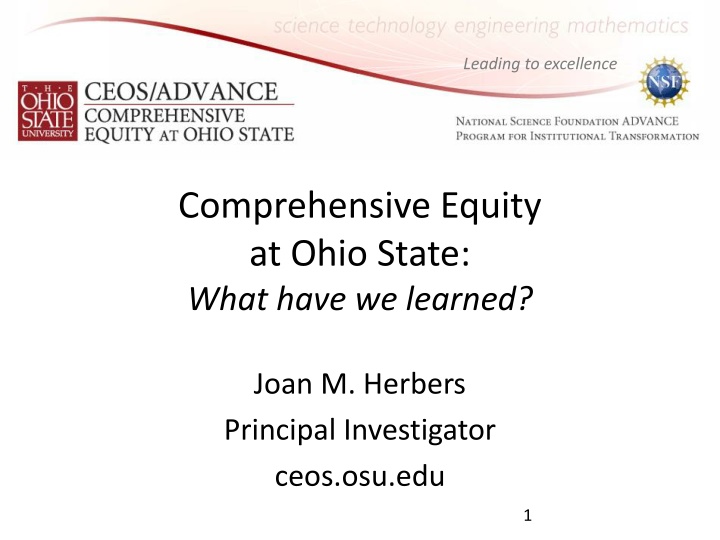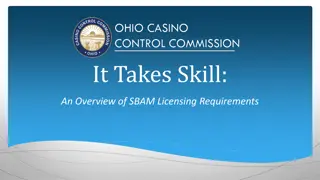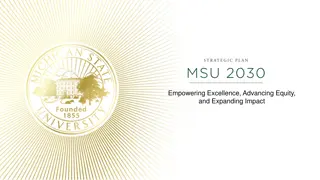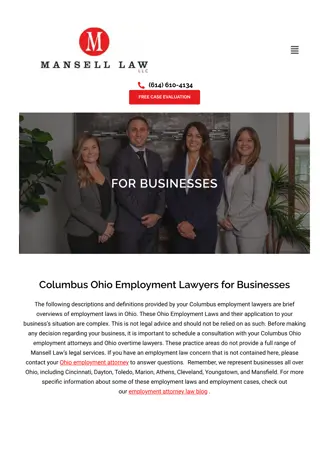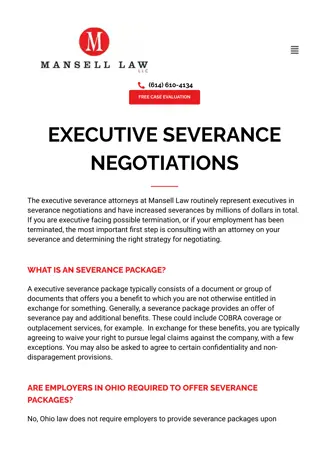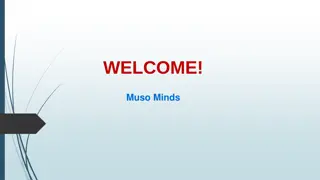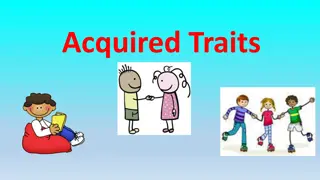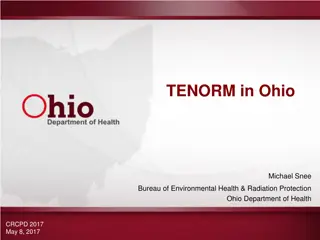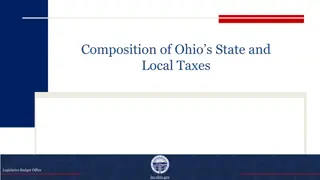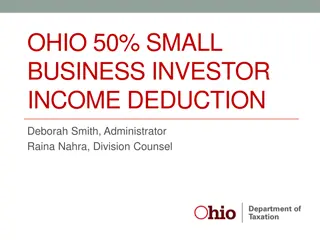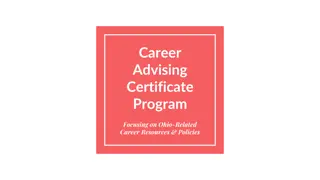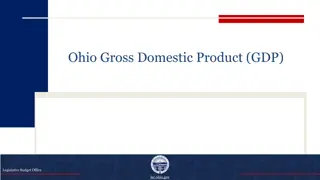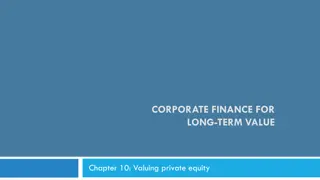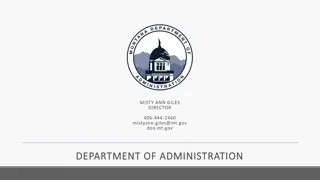Comprehensive Equity at Ohio State: Lessons Learned
The Comprehensive Equity at Ohio State (CEOS) project focuses on advancing women in STEM academic careers through the ADVANCE program. It explores systemic approaches for institutional transformation, supported by a $3.6M grant. Transformational leadership, inclusive practices, and project elements like leadership workshops and peer mentoring are key components. Effective leadership from Deans and Chairs is crucial for the success of women faculty in STEM fields. The project has covered topics like the science of gender equity, cultural assumptions, and diversity in academia, aiming to foster a more diverse and inclusive academic environment, particularly in STEM disciplines.
Download Presentation

Please find below an Image/Link to download the presentation.
The content on the website is provided AS IS for your information and personal use only. It may not be sold, licensed, or shared on other websites without obtaining consent from the author.If you encounter any issues during the download, it is possible that the publisher has removed the file from their server.
You are allowed to download the files provided on this website for personal or commercial use, subject to the condition that they are used lawfully. All files are the property of their respective owners.
The content on the website is provided AS IS for your information and personal use only. It may not be sold, licensed, or shared on other websites without obtaining consent from the author.
E N D
Presentation Transcript
Leading to excellence Comprehensive Equity at Ohio State: What have we learned? Joan M. Herbers Principal Investigator ceos.osu.edu 1
Leading to excellence Context: The ADVANCE program at the National Science Foundation (NSF) Our project: CEOS 2
Leading to excellence ADVANCE is embedded within the NSF Plan for Broadening Participation Goal: to develop systemic approaches to increase the representation and advancement of women in academic STEM careers, thereby contributing to the development of a more diverse science and engineering workforce. Institutional Transformation (IT) include innovative systemic organizational approaches to comprehensively transform institutions in ways that will increase the participation and advancement of women in STEM academic careers. must include a research component designed to study the effectiveness of the proposed innovations in order to contribute to the knowledge base informing academic institutional transformation 3
Leading to excellence OSU Funding: $3.6M, 5-year grant starting Sept. 08 Focus on three units: Veterinary Medicine, Engineering, and Division of Natural and Mathematical Sciences 4
Leading to excellence A model of Transformational Leadership structures our work Vision of Support and Inclusiveness Cultural Assumptions Questioned and Shifted Individual Needs Understood and Met Transformational Leadership Changed Practices Accommodate Diversity Flexible Career Policies 5
Leading to excellence Four Elements of Project CEOS 1. Leadership workshops for deans and department chairs 2. Peer mentoring for women leaders in the STEM Colleges 3. Project REACH commercializing research 4. Action learning teams to work on specific cultural issues uncovered in our work
Leading to excellence Effective leadership from Deans and Chairs is critical to the success of women faculty in STEM 1. Winter 2009: are there connections between academic excellence, leadership, and diversity? 2. Spring 2009: The science of gender equity studies; results from OSU culture survey 3. Autumn 2009: Leading Change in the Academy 4. Autumn 2009: Do babies matter in academia? 5. Winter 2010: Search Committee strategies 6. Spring 2010: Diversity and excellence 7. Summer 2010: World Caf on local issues affecting gender equity
Leading to excellence Sources of Data Two World Cafes Leadership Inventory Five sets of Workshop Feedback Interviews with Deans and Chairs 8
Leading to excellence Results Workshops: Participants gained more insight, more facts and an altered perspective Interviews: Considerablevariety in departmental culture and practice Repeated emphasis that CEOS has helped make diversity a front burner issue Little actual action on CEOS issues mentioned We need your help to document impact of our work 9
Leading to excellence Peer Mentoring helps women faculty find paths to success 1. Monthly meetings for tenured women faculty 2. Facilitated by an external consultant to maintain focus on strategies for success and to protect confidentiality 3. Participants are eager to share their discoveries with academic leaders 4. Starting this year, the emphasis will shift to explicit leadership training
Leading to excellence Sources of Data Two questionnaires One set of annual reflective essays World Caf Results Participation reported as useful Participants expressed a desire to act upon what they learned: communication with administrative leaders and development of action plans 11
Leading to excellence Successful women entrepreneurs are motivated by social impact 1. Emphasis on extending the REACH of research discovery 2. Four workshops Successful women entrepreneurs at Ohio State Skills and behaviors needed for successful commercialization Introduction to staff at Office of Technology Licensing and Commercialization, including personalized review of research potential for the marketplace The world of business (OSU incubator, angel investing, and venture capital)
Leading to excellence Sources of Data Self Assessment Workshop Feedback Results Participants need familiarity with the business world and opportunities for collaboration Participants would like : more workshops more knowledge of and access to University resources incentives for and support of commercialization activity 13
Leading to excellence Primary challenges identified by OSU faculty 1. Mentoring 2. Transparency 3. Research infrastructure 4. Recognition and Appreciation/ awards structure 5. Department Culture
Leading to excellence What is your experience at OSU? Small group discussions on the top two issues, mentoring and transparency Focus on how the issue manifests itself in your unit positive and negative and suggest practices that can improve the local culture Report out and decide upon individualized action for your unit 15
